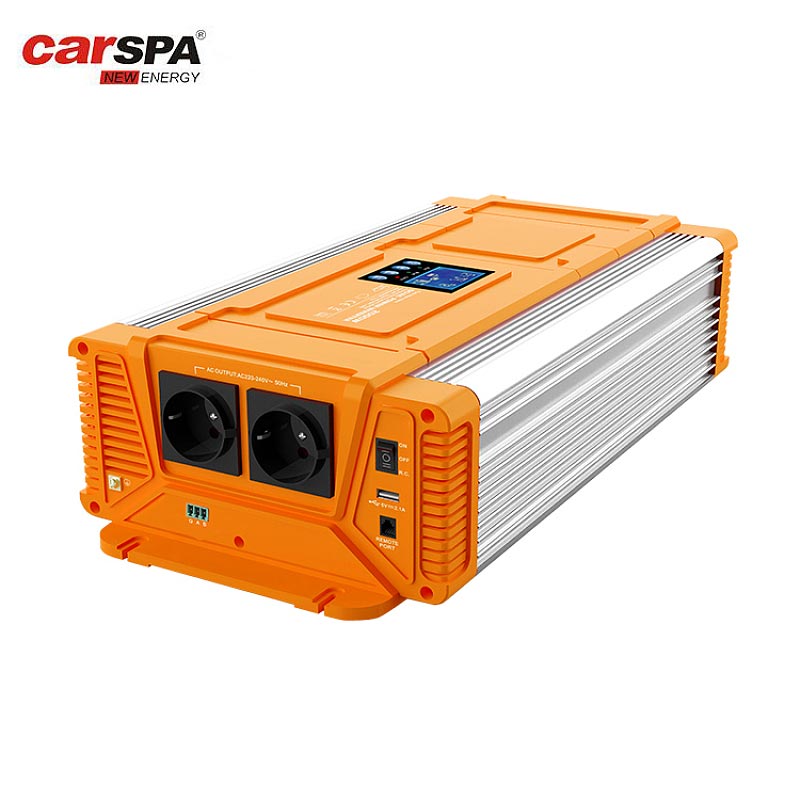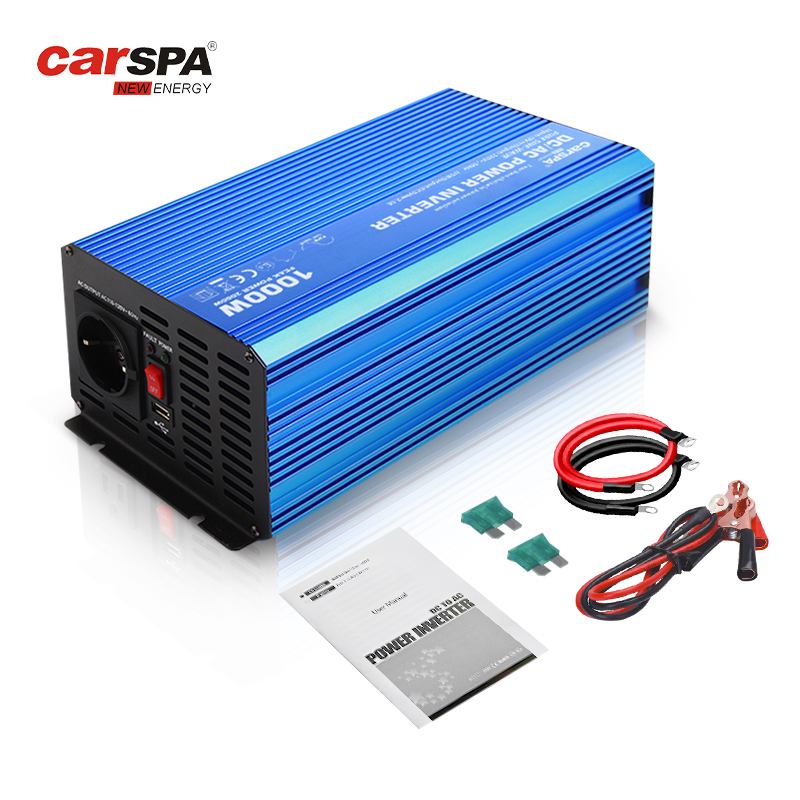What is the Difference Between 1000 Watt and 2000 Watt Inverter?
When choosing an inverter, many people will encounter an important question: should I choose a 1000 Watt or 2000 Watt inverter? The two are not only different in power, but also in usage scenarios, performance, price, and battery requirements. In order to help you better understand the difference between the two inverters and make a choice that suits your needs, this article will analyze the differences between 1000 Watt and 2000 Watt inverters in detail from multiple angles.
1. What is the power difference between 1000 Watt and 2000 Watt inverters?
Power is the most basic parameter of an inverter and the primary consideration when choosing an inverter. The power size directly affects the types and number of devices that the inverter can power.
What is the rated power of an inverter?
The rated power of an inverter refers to the maximum power it can output under normal working conditions, usually in watts (W). A 1000W power inverter means that it can continuously power devices with a power of no more than 1000W, while a 2000W power inverter can power devices with a power of no more than 2000W.
For example, an ordinary refrigerator has a power of about 400W, and a 1000W power inverter can easily support its normal operation. If you also need to power a microwave oven (usually with a power of 800W), a 1000W power inverter may not be able to meet the needs, and a 2000W power inverter is needed.
Rated power and starting power
It is worth noting that some devices (especially those with motors, such as refrigerators, air conditioners, microwave ovens, etc.) will generate 2 to 3 times higher starting power than their rated power when starting. This means that although the rated power of the device is below 1000W, its starting power may exceed 1000W, causing the 1000W power inverter to be unable to load. Therefore, a 2000W power inverter can not only carry a larger continuous power, but also cope with a higher starting power.
For example, a 500W refrigerator may use up to 1500W of power when it starts. A 1000W power inverter may shut down due to the high power demand at startup, while a 2000W power inverter will be able to handle this and start the device smoothly.
Power calculation example
Suppose you need to power the following devices:
Refrigerator: 500W
TV: 150W
Desk lamp: 50W
Total power:
500W+150W+50W=700W
At this point, a 1000W power inverter is enough to power these devices. If you also need to power other high-power devices, such as an electric kettle (1500W), then you will need a 2000W power inverter to meet the needs of all devices.
2. What are the differences in the applicable scenarios of 1000W and 2000W power inverters?
The applicable scenario of the inverter mainly depends on its power size. Different power is suitable for different equipment types and usage environments, so it is very important to understand the application scenarios of 1000W and 2000W power inverters.
Applicable scenarios of 1000W power inverter
1000-watt power inverter is very suitable for powering some small electronic devices and household appliances, especially when camping outdoors, car power supply or short-term power outage emergency, 1000W power inverter can meet most needs.
Common applicable devices include:
Laptop: The power is usually between 50-100W, and a 1000W power inverter can charge multiple laptops at the same time.
TV: Most ordinary TVs have a power of 150-300W, and a 1000W power inverter can support them to run for a long time.
Small refrigerator: The power of a small household refrigerator is about 100-500W, and a 1000W power inverter is enough to support its normal operation.
Mobile phones and small appliances: such as mobile phone chargers, desk lamps, fans, etc., have low power, and a 1000W power inverter can fully meet the needs of these devices.
1000W power inverter is very suitable for light outdoor activities, such as camping, RV travel, or as an emergency power supply during power outages. It can provide you with sufficient power support, but at the same time maintain portability and efficiency.
Applicable scenarios of 2000W power inverter
In contrast, 2000W power inverter is suitable for more high-power devices and is suitable for scenarios that require more power support. For example, in RVs, home backup power or some small construction sites, 2000W power inverter can power multiple high-power devices at the same time.
Common applicable devices include:
Microwave oven: The power is usually between 800W and 1500W, and the 2000W power inverter can provide stable power for microwave ovens.
Electric kettle: The power is between 1200W and 1500W, and the 2000W power inverter can easily drive the electric kettle.
Air conditioner: The power of small air conditioners is usually between 1000W and 2000W, and the 2000W power inverter can provide them with sufficient power support.
Power tools: such as electric saws and electric drills, the power is usually more than 1000 watts, and a 2000 watt inverter can support the simultaneous operation of multiple power tools.
Therefore, 2000 watt inverters are more used in occasions with higher power requirements, suitable for scenarios that require long-term, high-power power supply, such as home backup power, RV travel, or small construction site power supply.
3. What is the difference between 1000 watt and 2000 watt inverters in battery requirements?
The power size of the inverter not only affects the type of equipment it can power, but also determines the battery requirements. Inverters of different powers also require different battery capacities and quantities.
Calculation formula for battery requirements
To calculate the number of batteries required for an inverter, we need to consider the inverter power, runtime, battery voltage, and inverter efficiency. The basic formula is as follows:
Battery capacity (Ah) = inverter power (W) × running time (h) / (battery voltage (V) × inverter efficiency)
Assume that we use a 12V battery, the inverter efficiency is 90%, and the inverter is required to run for 5 hours. We can calculate the battery capacity required for 1000W and 2000W power inverters respectively.
For 1000W power inverter:
Battery capacity (Ah) = 1000W×5h/(12V×0.9)≈463Ah
For 2000W power inverter:
Battery capacity (Ah) = 2000W×5h/(12V×0.9)≈926Ah
From here, it can be seen that the battery capacity required for a 2000W power inverter is twice that of a 1000W power inverter. Therefore, when choosing a battery, a 2000W power inverter requires more batteries to maintain the same running time.
Calculation of the number of batteries
Most 12V deep cycle batteries usually have a capacity of 100Ah or 200Ah. Assuming that we use a 100Ah battery to support the inverter operation, we can calculate the number of batteries required:
For a 1000W power inverter: 463Ah/100Ah=4.63≈5 batteries
For a 2000W power inverter:
926Ah/100Ah=9.26≈10 batteries
Therefore, the number of batteries required for a 2000W power inverter is almost twice that of a 1000W power inverter under the same conditions. If you need to choose a battery for a longer power supply, the battery demand and cost of the 2000W power inverter will increase accordingly.
4. What are the costs and cost-effectiveness of 1000W and 2000W power inverters?
The power size not only affects the performance of the inverter, but also directly affects its price. Generally speaking, the higher the power of the inverter, the higher the price. At the same time, a high-power inverter may not be as efficient as a low-power inverter in some low-load situations. Therefore, when purchasing, you should not only consider the power of the inverter, but also the cost-effectiveness.
Cost Difference
Typically, the price of a 2000-watt inverter is about twice or even higher than that of a 1000-watt inverter. In addition, since a 2000-watt inverter requires more batteries and supporting equipment, this also increases the overall system cost. Therefore, unless you have a clear high-power demand, a 1000-watt inverter is a more cost-effective choice based on price alone.
Efficiency and Energy Consumption
The efficiency of an inverter is usually between 85% and 95%. Generally speaking, a 2000-watt inverter is more efficient than a 1000-watt inverter at full load, but an overpowered inverter may waste energy at low loads. Therefore, if you are mainly powering small devices, choosing a 1000-watt inverter can be more energy-efficient, while a 2000-watt inverter is suitable for occasions that require more powerful devices.
Conclusion
The main differences between 1000W and 2000W power inverters are their power, applicable scenarios, usage efficiency, and battery requirements. 1000W power inverters are suitable for powering small appliances and electronic devices, especially for outdoor camping or small home backup power. 2000W power inverters are more suitable for powering high-power devices, such as microwave ovens, electric kettles, air conditioners, etc., and are more suitable for high-power demand scenarios such as RVs or small construction sites.
When choosing, you need to make a decision based on your actual needs. If you are mainly powering some low-power devices, then a 1000 watt power inverter is enough to meet the needs; but if you have multiple high-power devices that need to be powered at the same time, then a 2000W power inverter may be a better choice. At the same time, inverters of different powers have different requirements for batteries. When designing the power supply system, the number and capacity of batteries need to be considered to ensure the stability and durability of the power supply.
No matter which inverter you choose, it is recommended to make a reasonable configuration according to the actual situation to ensure the efficient operation and economy of the system.

.jpg)
.jpg)






